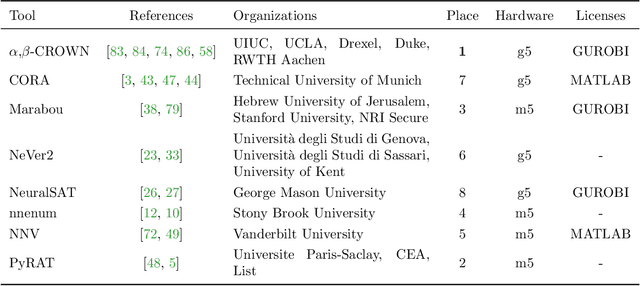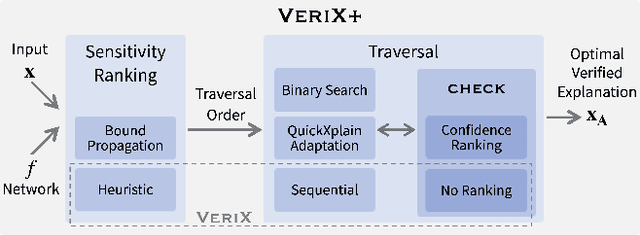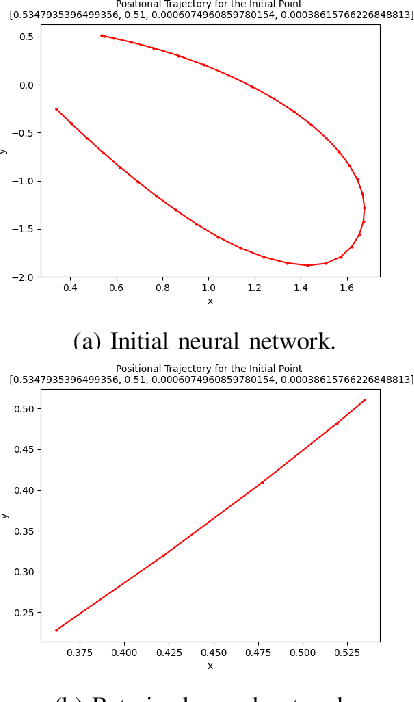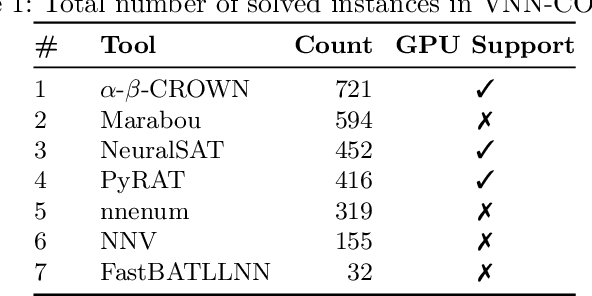Haoze Wu
Abstraction-Based Proof Production in Formal Verification of Neural Networks
Jun 11, 2025Abstract:Modern verification tools for deep neural networks (DNNs) increasingly rely on abstraction to scale to realistic architectures. In parallel, proof production is becoming a critical requirement for increasing the reliability of DNN verification results. However, current proofproducing verifiers do not support abstraction-based reasoning, creating a gap between scalability and provable guarantees. We address this gap by introducing a novel framework for proof-producing abstraction-based DNN verification. Our approach modularly separates the verification task into two components: (i) proving the correctness of an abstract network, and (ii) proving the soundness of the abstraction with respect to the original DNN. The former can be handled by existing proof-producing verifiers, whereas we propose the first method for generating formal proofs for the latter. This preliminary work aims to enable scalable and trustworthy verification by supporting common abstraction techniques within a formal proof framework.
Proof-Driven Clause Learning in Neural Network Verification
Mar 15, 2025Abstract:The widespread adoption of deep neural networks (DNNs) requires efficient techniques for safety verification. Existing methods struggle to scale to real-world DNNs, and tremendous efforts are being put into improving their scalability. In this work, we propose an approach for improving the scalability of DNN verifiers using Conflict-Driven Clause Learning (CDCL) -- an approach that has proven highly successful in SAT and SMT solving. We present a novel algorithm for deriving conflict clauses using UNSAT proofs, and propose several optimizations for expediting it. Our approach allows a modular integration of SAT solvers and DNN verifiers, and we implement it on top of an interface designed for this purpose. The evaluation of our implementation over several benchmarks suggests a 2X--3X improvement over a similar approach, with specific cases outperforming the state of the art.
Neural Network Verification is a Programming Language Challenge
Jan 10, 2025Abstract:Neural network verification is a new and rapidly developing field of research. So far, the main priority has been establishing efficient verification algorithms and tools, while proper support from the programming language perspective has been considered secondary or unimportant. Yet, there is mounting evidence that insights from the programming language community may make a difference in the future development of this domain. In this paper, we formulate neural network verification challenges as programming language challenges and suggest possible future solutions.
* Accepted at ESOP 2025, European Symposium on Programming Languages
The Fifth International Verification of Neural Networks Competition (VNN-COMP 2024): Summary and Results
Dec 28, 2024



Abstract:This report summarizes the 5th International Verification of Neural Networks Competition (VNN-COMP 2024), held as a part of the 7th International Symposium on AI Verification (SAIV), that was collocated with the 36th International Conference on Computer-Aided Verification (CAV). VNN-COMP is held annually to facilitate the fair and objective comparison of state-of-the-art neural network verification tools, encourage the standardization of tool interfaces, and bring together the neural network verification community. To this end, standardized formats for networks (ONNX) and specification (VNN-LIB) were defined, tools were evaluated on equal-cost hardware (using an automatic evaluation pipeline based on AWS instances), and tool parameters were chosen by the participants before the final test sets were made public. In the 2024 iteration, 8 teams participated on a diverse set of 12 regular and 8 extended benchmarks. This report summarizes the rules, benchmarks, participating tools, results, and lessons learned from this iteration of this competition.
USM: Unbiased Survey Modeling for Limiting Negative User Experiences in Recommendation Systems
Dec 14, 2024Abstract:Negative feedback signals are crucial to guardrail content recommendations and improve user experience. When these signals are effectively integrated into recommendation systems, they play a vital role in preventing the promotion of harmful or undesirable content, thereby contributing to a healthier online environment. However, the challenges associated with negative signals are noteworthy. Due to the limited visibility of options for users to express negative feedback, these signals are often sparse compared to positive signals. This imbalance can lead to a skewed understanding of user preferences, resulting in recommendations that prioritize short-term engagement over long-term satisfaction. Moreover, an over-reliance on positive signals can create a filter bubble, where users are continuously exposed to content that aligns with their immediate preferences but may not be beneficial in the long run. This scenario can ultimately lead to user attrition as audiences become disillusioned with the quality of the content provided. Additionally, existing user signals frequently fail to meet specific customized requirements, such as understanding the underlying reasons for a user's likes or dislikes regarding a video. This lack of granularity hinders our ability to tailor content recommendations effectively, as we cannot identify the particular attributes of content that resonate with individual users.
Better Verified Explanations with Applications to Incorrectness and Out-of-Distribution Detection
Sep 04, 2024



Abstract:Building on VeriX (Verified eXplainability, arXiv:2212.01051), a system for producing optimal verified explanations for machine learning model outputs, we present VeriX+, which significantly improves both the size and the generation time of verified explanations. We introduce a bound propagation-based sensitivity technique to improve the size, and a binary search-based traversal with confidence ranking for improving time -- the two techniques are orthogonal and can be used independently or together. We also show how to adapt the QuickXplain (Junker 2004) algorithm to our setting to provide a trade-off between size and time. Experimental evaluations on standard benchmarks demonstrate significant improvements on both metrics, e.g., a size reduction of 38% on the GTSRB dataset and a time reduction of 90% on MNIST. We also explore applications of our verified explanations and show that explanation size is a useful proxy for both incorrectness detection and out-of-distribution detection.
Safe and Reliable Training of Learning-Based Aerospace Controllers
Jul 09, 2024


Abstract:In recent years, deep reinforcement learning (DRL) approaches have generated highly successful controllers for a myriad of complex domains. However, the opaque nature of these models limits their applicability in aerospace systems and safety-critical domains, in which a single mistake can have dire consequences. In this paper, we present novel advancements in both the training and verification of DRL controllers, which can help ensure their safe behavior. We showcase a design-for-verification approach utilizing k-induction and demonstrate its use in verifying liveness properties. In addition, we also give a brief overview of neural Lyapunov Barrier certificates and summarize their capabilities on a case study. Finally, we describe several other novel reachability-based approaches which, despite failing to provide guarantees of interest, could be effective for verification of other DRL systems, and could be of further interest to the community.
GW-MoE: Resolving Uncertainty in MoE Router with Global Workspace Theory
Jun 18, 2024



Abstract:Mixture-of-Experts (MoE) has been demonstrated as an efficient method to scale up models. By dynamically and sparsely selecting activated experts, MoE can effectively reduce computational costs. Despite the success, we observe that many tokens in the MoE models have uncertain routing results. These tokens have nearly equal scores for choosing each expert, and we demonstrate that this uncertainty can lead to incorrect selections. Inspired by the Global Workspace Theory (GWT), we propose a new fine-tuning method, GW-MoE, to address this issue. The core idea is to broadcast the uncertain tokens across experts during fine-tuning. Therefore, these tokens can acquire the necessary knowledge from any expert during inference and become less sensitive to the choice. GW-MoE does not introduce additional inference overhead. We validate that GW can mitigate the uncertain problem and consistently improve in different tasks (text classification, question answering, summarization, code generation, and mathematical problem solving) and model sizes (650M and 8B parameters).
Formally Verifying Deep Reinforcement Learning Controllers with Lyapunov Barrier Certificates
May 22, 2024Abstract:Deep reinforcement learning (DRL) is a powerful machine learning paradigm for generating agents that control autonomous systems. However, the "black box" nature of DRL agents limits their deployment in real-world safety-critical applications. A promising approach for providing strong guarantees on an agent's behavior is to use Neural Lyapunov Barrier (NLB) certificates, which are learned functions over the system whose properties indirectly imply that an agent behaves as desired. However, NLB-based certificates are typically difficult to learn and even more difficult to verify, especially for complex systems. In this work, we present a novel method for training and verifying NLB-based certificates for discrete-time systems. Specifically, we introduce a technique for certificate composition, which simplifies the verification of highly-complex systems by strategically designing a sequence of certificates. When jointly verified with neural network verification engines, these certificates provide a formal guarantee that a DRL agent both achieves its goals and avoids unsafe behavior. Furthermore, we introduce a technique for certificate filtering, which significantly simplifies the process of producing formally verified certificates. We demonstrate the merits of our approach with a case study on providing safety and liveness guarantees for a DRL-controlled spacecraft.
Marabou 2.0: A Versatile Formal Analyzer of Neural Networks
Jan 25, 2024


Abstract:This paper serves as a comprehensive system description of version 2.0 of the Marabou framework for formal analysis of neural networks. We discuss the tool's architectural design and highlight the major features and components introduced since its initial release.
 Add to Chrome
Add to Chrome Add to Firefox
Add to Firefox Add to Edge
Add to Edge